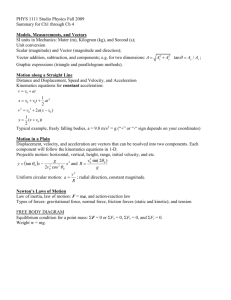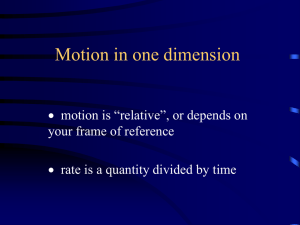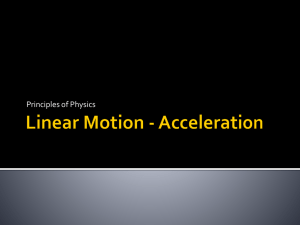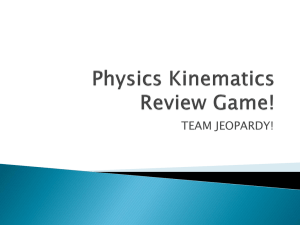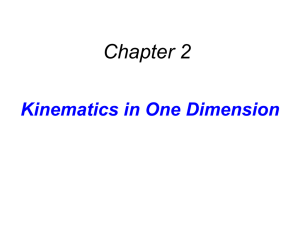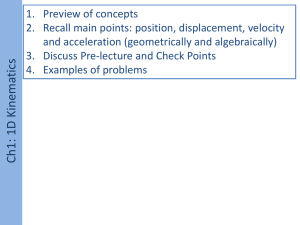PHYS 1401 General College Physics I
advertisement
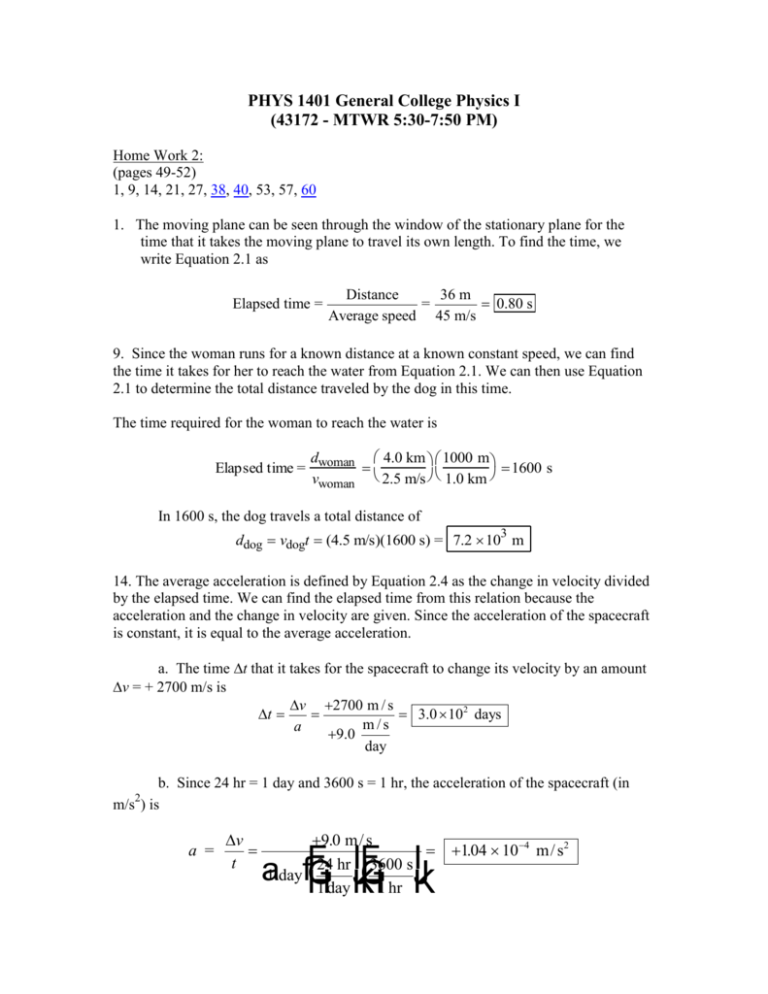
PHYS 1401 General College Physics I (43172 - MTWR 5:30-7:50 PM) Home Work 2: (pages 49-52) 1, 9, 14, 21, 27, 38, 40, 53, 57, 60 1. The moving plane can be seen through the window of the stationary plane for the time that it takes the moving plane to travel its own length. To find the time, we write Equation 2.1 as Elapsed time = Distance 36 m = 0.80 s Average speed 45 m/s 9. Since the woman runs for a known distance at a known constant speed, we can find the time it takes for her to reach the water from Equation 2.1. We can then use Equation 2.1 to determine the total distance traveled by the dog in this time. The time required for the woman to reach the water is d 4.0 km 1000 m Elapsed time = woman 1600 s vwoman 2.5 m/s 1.0 km In 1600 s, the dog travels a total distance of ddog vdogt (4.5 m/s)(1600 s) = 7.2 103 m 14. The average acceleration is defined by Equation 2.4 as the change in velocity divided by the elapsed time. We can find the elapsed time from this relation because the acceleration and the change in velocity are given. Since the acceleration of the spacecraft is constant, it is equal to the average acceleration. a. The time t that it takes for the spacecraft to change its velocity by an amount v = + 2700 m/s is v 2700 m / s t 3.0 102 days m/s a 9.0 day b. Since 24 hr = 1 day and 3600 s = 1 hr, the acceleration of the spacecraft (in m/s ) is 2 a = v t 9.0 m/ s 24 hr 3600 s 1 day 1 day 1 hr a IJF IJ fF G G H KH K 104 . 10 4 m/ s2 21. The average acceleration is defined by Equation 2.4 as the change in velocity divided by the elapsed time. We can find the elapsed time from this relation because the acceleration and the change in velocity are given. a. The time t that it takes for the VW Beetle to change its velocity by an amount v = v – v0 is (and noting that 0.4470 m/s = 1 mi/h) t v v0 a 0.4470 m / s 0 m/s 1 mi / h 60.0 mi / h 2.35 m / s 2 11.4 s b. From Equation 2.4, the acceleration (in m/s2) of the dragster is a v v0 t t0 0.4470 m / s 0 m/s 1 mi / h 60.0 mi / h 0.600 s 0 s 44.7 m / s 2 27. Since the belt is moving with constant velocity, the displacement ( x0 0 m) covered by the belt in a time t belt is giving by Equation 2.2 (with x0 assumed to be zero) as x v beltt belt (1 ) Since Clifford moves with constant acceleration, the displacement covered by Clifford in a time tCliff is, from Equation 2.8, 2 x v0 tCliff 2 atCliff 2 at 2Cliff 1 1 The speed v belt with which the belt of the ramp is moving can be found by eliminating x between Equations (1) and (2). Equating the right hand sides of Equations (1) and (2), and noting that 1 tCliff 4 t belt , we have 1 1 v beltt belt 2 a( 4 t belt )2 vbelt 1 32 atbelt 321 (0.37 m/s2 )(64 s) = 0.74 m/s (2 ) 53. The stone requires a time, t1, to reach the bottom of the hole, a distance y below the ground. Assuming downward to be the positive direction, the variables are related by Equation 2.8 with v0 0 m/s: 1 2 y 2 at1 (1 ) The sound travels the distance y from the bottom to the top of the hole in a time t2 . Since the sound does not experience any acceleration, the variables y and t2 are related by Equation 2.8 with a 0 m/s2 and vsound denoting the speed of sound: y vsound t2 Equating the right hand sides of Equations (1) and (2) and using the fact that the total elapsed time is t t1 t2 , we have 1 2 at 12 vsoundt 2 or 2 at 1 v sound (t t 1 ) Rearranging gives 1 2 at vsound t1 – vsoundt 0 2 1 1 2 Substituting values and suppressing units for brevity, we obtain the following quadratic equation for t1: 4.90t12 343t1 – 514 0 From the quadratic formula, we obtain –343 (343) 2 4(4.90)(–514) t1 1.47 s or – 71.5 s 2(4.90) The negative time corresponds to a nonphysical result and is rejected. The depth of the hole is then found using Equation 2.8 with the value of t1 obtained above: (2) 57. In order to construct the graph, the time for each segment of the trip must be determined. From the definition of average velocity t x v Therefore, 10.0 km 60 min t1 40 min 15.0 km/h 1.0 h 15.0 km 60 min t2 90 min 10.0 km/h 1.0 h Thus, the second time interval ends 40 min + 90 min = 130 min after the trip begins. 15.0 km 60 min t3 180 min 5.0 km/h 1.0 h and the third time interval ends 130 min + 180 min = 310 min after the trip begins. Position from starting point (km) 50 40 30 20 10 0 50 100 150 200 250 300 Time (min) Note that the slope of each segment of the graph gives the average velocity during that interval.
